Everything you need to know about the UTMB
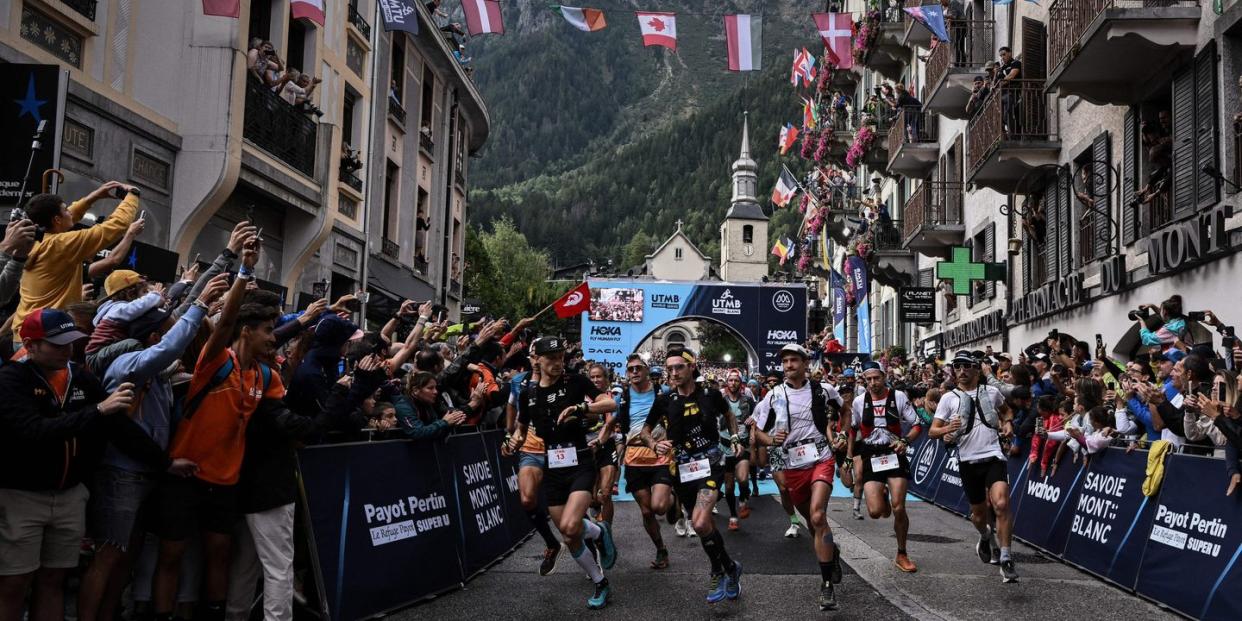
Created in 2003, the UTMB has been dubbed as ‘the most prestigious trail running race in the world’ – and is seen by many trail runners as the ultimate test of mental strength and endurance. Roughly 2,600 runners take on the alpine challenge – featuring 360-degree views of Mont Blanc – in under 46 hours 30 minutes.
Here’s everything you need to know about the iconic Chamonix race...
What does UTMB stand for?
UTMB stands for Ultra-Trail du Mont-Blanc.
What is the UTMB?
An iconic 106-mile race, with 32,700ft elevation around the Mont-Blanc through Italy, Switzerland and France.
How to qualify for the UTMB?
To participate in the UTMB World Final, you have to enter the lottery.
In order to enter the lottery you must have;
A valid UTMB index in the 100K or 100M categories
At least one running stone
What’s a Running Stone?
A running stone provides one entry in the lottery to participate in the UTMB World Series Finals. You can collect running stones by finishing a 20K, 50K, 100K or 100M race of the UTMB World Series circuit. Running stones are recorded on your runner’s account and each running stone improves your odds in the lottery.
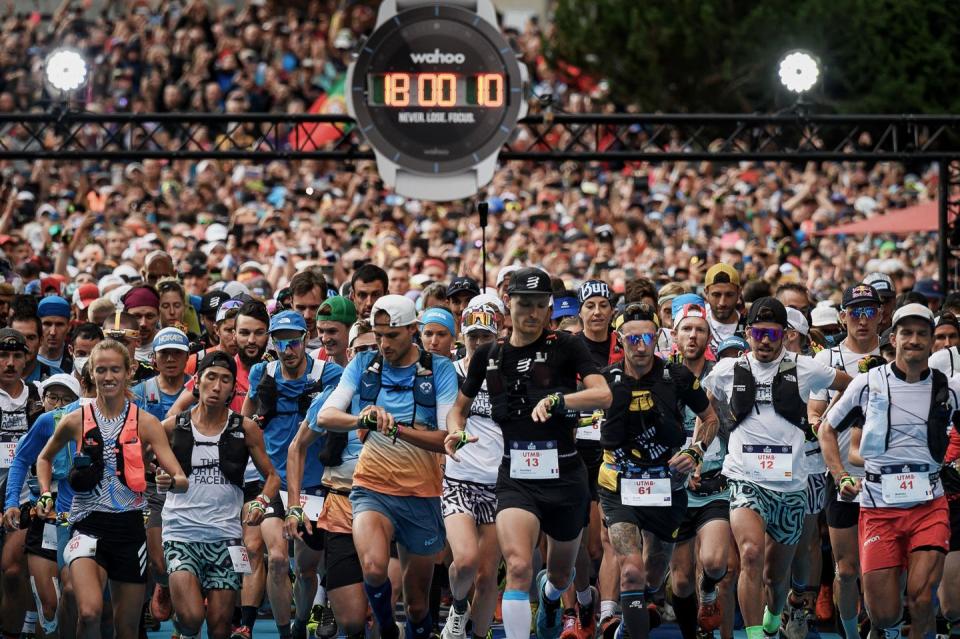
The history behind the UTMB
As the Ulta-Trail du Mont-Blanc celebrates its 20th anniversary, Duncan Craig unravels the history of an iconic event that lives deep in the hearts and minds of trail runners all over the world...
The first time I heard those now-fabled initials – UTMB – I was in the Moroccan Sahara: a husk of myself, morale teetering, lips as cracked as the wadis we’d spent the best part of a week running through. I was tackling the Marathon des Sables – the self-styled ‘toughest race in the world’. The sinewy Italian chap next to me in the medic’s tent was intent on small talk. Dispiriting small talk. ‘If you think this is tough,’ he said, watching the volunteer dab my bloodied feet, ‘wait until you try the UTMB’.
It was another two years before I got the chance (for those of us of such a mentality, his was an irresistible sales pitch). By then, the Ultra-Trail du Mont-Blanc (UTMB) was in its seventh year and picking up pace inexorably, like a long-distance specialist cresting a final summit.
Every trail runner knew the daunting stats: 106 miles; 32,700ft of aggregate climb; three countries ticked off in an on-stop loop around western Europe’s highest mountain. Every trail runner had heard the tales of the 10-deep crowds at the start and finish in Chamonix, the carnival atmosphere, the unpredictable weather, the cowbells and hallucinations, the multinational camaraderie. And everyone wanted a taste.
That was 2009. Now, fourteen years on, as the UTMB celebrates its 20th anniversary, the race finds itself not just at the pinnacle of the burgeoning and interconnected sports of trail running and ultramarathoning – but as one of the world’s greatest sporting events in its own right. The exponential growth, year on year, has been dizzying: in innovation, in sponsorship, in marketing, in theatre, in global audience, in prestige. For elite athletes, a win in Chamonix can be worth a six-figure sum in spin-off benefits and endorsements. For the amateur, a finish is worth double that in enduring pride and satisfaction.
Over the years, seven offshoot races of varying lengths have been added, achieving its founders’ dream of establishing an end-of-summer festival of running (think: Glastonbury with added chafing). Nearly 500 accredited media cover the races; tens of thousands apply to run and millions tune in to L’Equipe’s live broadcast and the UTMB Live streaming platform. Post-pandemic, UTMB has gone global, too, spawning a World Series with 36 events and 137 races on five continents. Harnessing the commercial and logistical might of new partner Ironman, that number could nearly double in the coming years.
Such runaway success is not to everyone’s liking, of course. Some say it has become a monopolistic force, freezing out smaller races. Others that it’s fettering this most free-spirited of sports with needless and self-serving structure. The most common accusation is that, through its strategic partnership with Ironman – not exactly renowned for its dearth of ambition – it has, quite simply, sold out.
Whatever you think of such claims – and we’ll analyse them in more detail later – they’re grounded in one indisputable fact: so prodigious has been UTMB’s growth over the past two decades, it now has the power to influence an entire sport.
So what lies at the heart of this race’s stratospheric rise, what are the moments that have established its reputation and what are the challenges and opportunities ahead? To answer these questions, we need to rewind to the start, and a fleeting encounter in the streets of an autumnal Chamonix that was to have an indelible impact on this runner’s life – and that of tens of thousands of others around the world.
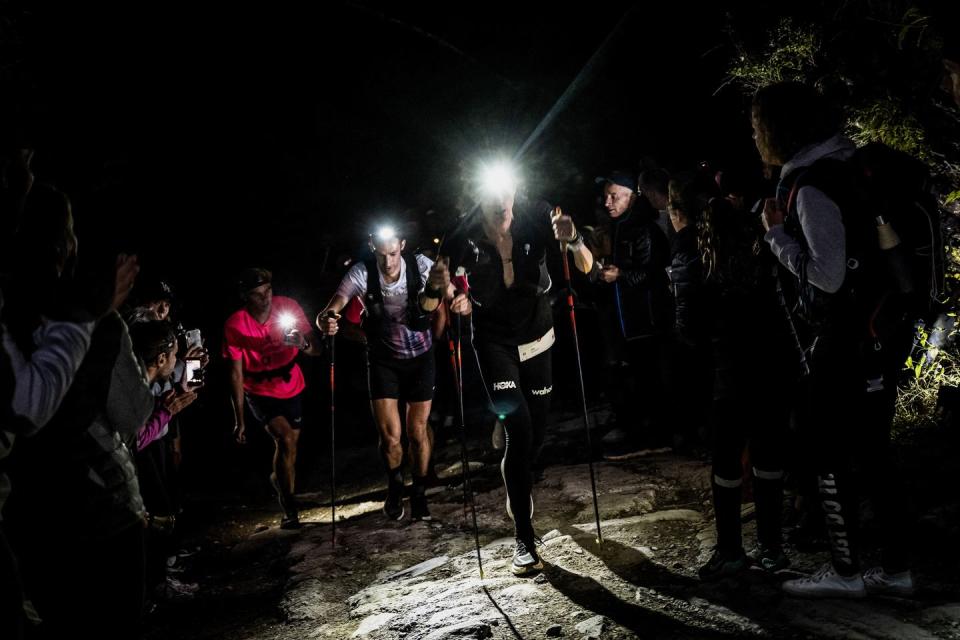
Even the most linguistically challenged could have a stab at translating ‘Place du Triangle de l’Amitié’. Something to do with friendship? Unity? Close enough. It’s the name of the distinctively triangular plaza in Chamonix that symbolises the cordiality between France, Italy and Switzerland; three Alpine countries that intersect just a handful of kilometres away.
Today, the plaza is the cacophonous epicentre of any UTMB experience. It’s the spot where you gather – heart pounding – on a Friday evening in late summer waiting for the off. A little under 20 hours later, with crowds spilling from balconies and cramming walkways, it serves as an even more raucous finish line – a role that it continues to play, with little let-up in gusto, for much of the subsequent 24 hours.
It was in this square on a more characteristically peaceful day in September 2002 that Michel Poletti bumped into René Bachelard. Bachelard – a former army general and the serving president of the local trail-running club – was restless. He wanted a race around Mont Blanc befitting the grandeur of the setting and celebrating the cooperation between the trio of neighbouring countries. Chamonix, the mountain-sport capital of Europe, the birthplace of Alpinism, the site of the inaugural Winter Olympics in 1924, was a ready-made focal point.
Races around Mont Blanc were actually nothing new. There had been road-based endeavours. There had been relays. But none had really captured the imagination, and the devastating Mont Blanc Tunnel fire just three years before, which claimed the lives of 39 people, had understandably diverted focus.
In Poletti, Bachelard knew he was pushing against an open door. Born and brought up in Chamonix, the younger man was a cross-country skier who had discovered trail running as a means to keep fit off-season. Captivated by Mont Blanc, he’d contemplated – and even, a few years previously, attempted – a non-stop circumnavigation, fashioning a route from the capillaries of paths worn into the granite massif over millennia by everyone from traders, herders and hikers to pilgrims and Roman soldiers. Crucially, he and his wife Catherine had an entrepreneurial flair. The pair had run a local record shop, started an IT business and – drawn to the Alps’ paragliding scene in the 1980s – even set up an international competition.
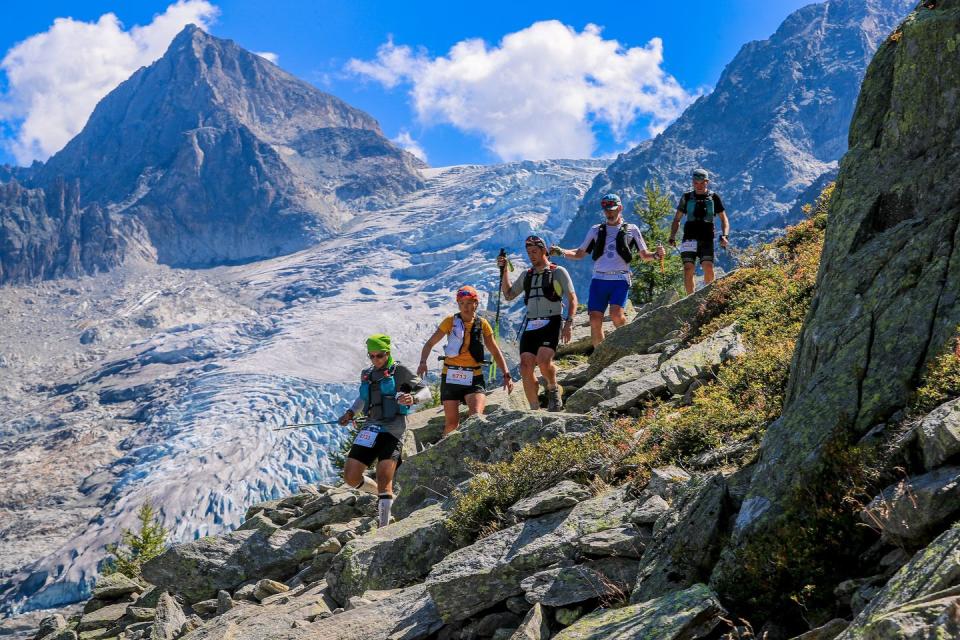
Bachelard bugged Poletti on the subject over the subsequent weeks, the latter eventually agreeing to arrange a meeting at a hotel in Chamonix. Among the attendees were Bachelard, the Polettis and Jean-Claude Marmier – a legendary mountaineer who founded the alpine division of the French Army. Marmier would pass away years later, in 2014, while marking out the course for his beloved La Petite Trotte à Léon (PTL), the most technical and longest of the UTMB offshoot races.
In October 2002, the now-expanded core of nine friends registered the race on the international calendar, picking a name – later shortened – that was almost as protracted as the course: the Ultra-Trail International du Tour du Mont-Blanc. Early in 2003, they had their first sign-up. Three hundred runners was their best-case scenario; when more than 700 people enrolled, the Polettis knew they were on to something.
That inaugural race in late August 2003 immediately established two UTMB traditions: first, that runners would likely have to contend with the meteorological kitchen sink being hurled at them, and second (and not entirely unrelated), that a significant number of entrants would end up with a ‘DNF’ appended to their name. In the 20 years since, the proportion not making it around the formidable, shark’s-teeth-profile course has hovered stubbornly around the one-third mark. For that first race, it was to be substantially higher.
American runner Krissy Moehl was the top female finisher in that first edition. That she was on her honeymoon, had never run 100 miles before and had to borrow kit from fellow runners gives you a sense of the improvised spirit of those early UTMB days. Unsure of runners’ capacity to make it around the entire loop, organisers offered two alternative finishes en route – in Courmayeur, Italy, 77km in; and in Champex-Lac, Switzerland, 46km from the end. This principle would, three years later, give rise to the truncated little sister of UTMB, the 100K CCC (Courmayeur-Champex-Chamonix).
Moehl battled through wind and snow and, supported at one point by a male French runner who would countenance nothing short of a full circumnavigation, finished in just shy of 30 hours. She was one of only 67 finishers.
Michel Poletti – that determined fellow runner Moehl had encountered – laughs fondly at the memory when I speak to him and Catherine ahead of the 2023 UTMB. Now in their late sixties, the couple share an easy chemistry, often finishing each other’s sentences. Insiders speak of their dovetailing characters and skill sets: he the trail-running purist and veteran of more than 80 ultras; she the driven, creative innovator.
Catherine confesses to being surprised at just how far the UTMB has come. ‘We didn’t imagine in 2003 that we’d reach this stage,’ she says. ‘But as it grew and grew we worked very hard, because we love the job and we love this area.’ Michel concurs, ‘In 2003 we immediately saw that it was going to be quite big and from that first event we organised ourselves to be able to stage a much bigger event. We had this ambition to grow it. But we were far away from imagining where we are now.’
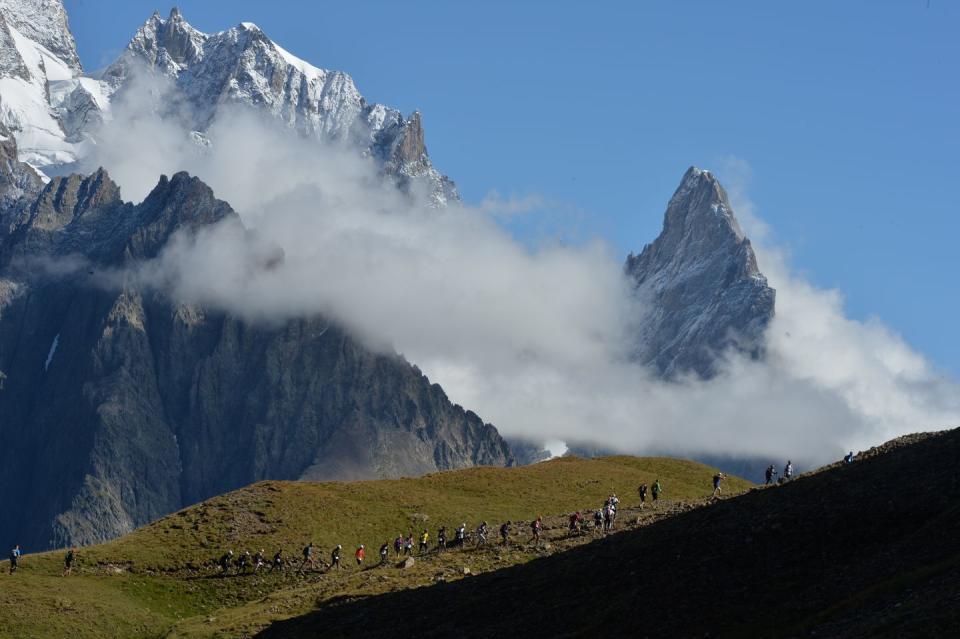
When it comes to the UTMB’s USP, the stats are only part of the story. After all, there are longer trail races – it’s often said these days that 200 is the new 100. Objectively harder ones, too – the 153-mile Spartathlon in Greece and the AostaValley’s barbaric 205-mile Tor des Géants among them. And there are more established ultras: the Western States 100 in California marks its 50th anniversary next year, for example.
Yet none, I submit, offer quite such a blend of soul-stirring beauty and soul-searching examination. Moehl recalls arriving in Chamonix for that 2003 race and straining her neck to see the peaks of the mountains from the window of her accommodation. It’s a sensation many UTMB-ers will be familiar with. The longest climb in the race, Col de la Croix du Bonhomme, incorporates 1,329m of ascent – the best part of a vertical mile. Never mind training on them, many will never have seen peaks of such scale. The emotions they stir among first-timers oscillate between awe, raw excitement and visceral terror.
After the stage-managed buzz of the start, the first big climb hits you like a gut punch. But it’s the remorseless descents you’ll come to fear – your trekking poles a feeble defence against the gravity pistoning through lactic-acid-flooded legs. These topographical highs and lows will be mirrored by your fluctuating mood and morale. I’ll never forget the misery and bone-deep chill of Grand Col Ferret, one of the highest points of the course at 2,537m. Nor the stream of sweat from the peak of my cap as I descended through a furnace-hot valley to Courmayeur and a leisure-centre aid station strewn with inert bodies.
But just as indelible in my mind are the waves of euphoria that flooded my depleted system intermittently, and the moments of blissful solitude in the early hours, when the vastness of the landscape was reduced to a bobbing beam of torchlight and the faint sound of laughter or music drifted up from the valley floor. For all the torment, there’s simply nowhere else you’d rather be.
One of the UTMB’s many endearing contradictions is that it’s a solo undertaking with a fierce camaraderie. Away from the sharp end of the race, it’s a binary battle (finish; don’t finish) fought entirely within yourself and against those mountains. Fellow runners aren’t the enemy; they’re right there in the trenches with you.
The huge local buy-in is a crucial part of the mix. It’s seen in the round-the-course, round-the-clock support – I think of the elderly lady stoically clapping me past her chalet’s gate at 4am in a squall – and in the army of volunteers. Numbering upwards of 2,300, they’d dwarf the field of many other ultras, and exhibit an expertise and empathy that runners appreciate more than they have the breath to say. Deservedly, the 40K MCC race from Martigny-Combe to Chamonix was added to the mix in 2018 specifically for local residents and volunteers.
‘The heart of the UTMB’s success is the link between everyone,’ says Catherine Poletti. ‘Runners, crews, volunteers, the locals, the partners. It’s a mix of skills, enthusiasm and energy. A big community.’
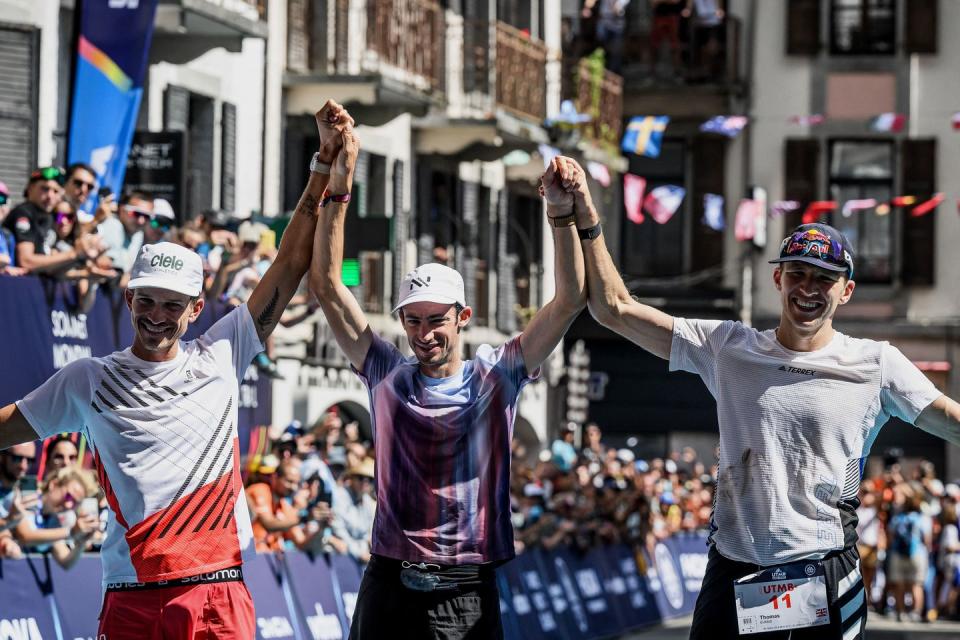
No runner is more indelibly linked with the UTMB than Kílian Jornet. The ‘GOAT of trail running’ is a four-time winner, the course record holder and the first to break 20 hours for a route that – lest we forget – mere mortals take anything up to nine days to hike.
Jornet is quick to praise the UTMB’s organisation and those effervescent volunteers. But he’s in no doubt what elevates the flagship race: the romantic simplicity of the endeavour. ‘This is Chamonix, Mont Blanc – the capital of Alpinism,’ he says. ‘Very few places in the world have such an aura. And you run around the mountain that is the highest in [western] Europe, so it’s not like it’s hard to explain.’
It can sometimes seem like UTMB has packed several decades’ worth of narratives into its first 20 years, creating those ‘I was there’ moments that are so crucial to sporting pedigree. That endlessly eventful inaugural race; 2007, when the ageless Italian runner Marco Olmo won his second title at the age of 59; the following year when the relatively unknown 21-year-old Jornet tore around the course in a time so quick organisers initially refused to verify it.
There have been podium controversies, time penalties, painkiller bans and bucketloads of intriguing subplots –one of the most striking is the contention, deepening with every passing year, that an American male is fated never to win Europe’s showpiece race.
Compelling characters litter the annals of UTMB. Britain’s Lizzy Hawker (‘Queen Elizabeth’, as she was coronated locally) won five titles in eight years from 2005, a feat still unparalleled. There’s the ongoing Nadal-Federer-Djokovic-style triopoly of Jornet (four wins), François D’Haene (four) and Xavier Thévenard (three). Courtney Dauwalter – the smiling assassin with the surfer shorts and contagious joie de vivre – scored a brace of wins bookending the pandemic-cancelled event in 2020. Her 2021 victory lowered the women’s record to 22:30:54 – nearly seven hours quicker than Krissy Moehl’s winning time in the inaugural race.
Could a female runner ever win the UTMB outright, I ask Dauwalter. ‘Oh man! Why shouldn’t my answer be yes?’ she replies. ‘Believing it’s possible does no harm and can only help women push a bit harder, and move them up the field.’
This roster of compelling elite runners has worked wonders to nourish the race’s profile – but it’s been a symbiotic relationship, something Jornet is humble enough to recognise. ‘It’s helped both sides,’ he explains. ‘The popularity of the race, the drama. We have taken advantage of each other.’
I put him on the spot: what’s his favourite UTMB memory? I’m expecting 2008 and that startling debut win. Perhaps 2022’s comeback victory, 14 years after his first? In fact, it’s 2011 – the year a snowstorm caused a five-hour delay.
‘The later start meant we got to see all the beautiful Italian mountains during the day that normally we pass at night,’ Jornet recalls. He ran with his compatriots Iker Karrera and Miguel Heras, as well as Frenchman Sébastien Chaigneau – the four urging each other on. ‘It was beautiful running together,’ says Jornet. ‘I was racing with my friends. It was fun.’
Fun? It’s not the first word I associate with running the UTMB. Is the race different for you elites, I ask him? Somehow – given all that conditioning and experience...easier? He laughs. ‘It’s not the stronger you are the easier you go,’ he says. ‘The stronger you are the harder you go, so my pain is the same as your pain. Each year varies, but for me, it’s probably 80% pain, 20% pleasure.’
Dauwalter agrees. She says she makes a conscious effort to take in the beauty of her surroundings on the UTMB, but there are often, when she looks back, ‘big gaps’. ‘My goal with every race is to make it hurt and get everything out of myself that I can. I’m trying to make it 80:20 or even 90:10.’ In 2021, she pushed so hard she started hallucinating, picturing a guitarist strumming away up ahead at dawn – but wondering why he made no sound and sat facing away from the trail.
I’m interested in the Polettis’ favourite moments, too; they have the broadest perspective, after all. Catherine points to the victories of Rory Bosio and Dauwalter, years apart, in 2013 and 2021. With neat symmetry, both Americans broke the women’s course record at the time and both finished seventh outright.
Michel – who has raced in eight UTMBs in total, completing seven – singles out Lizzy Hawker’s five wins between 2005 and 2012. On the male side, he points to the four-way duel between D’Haene, Jornet, Thévenardand Jim Walmsley in 2017.
It was an epic battle, for sure: three former UTMB winners and an American trail-running prodigy weighed down by a hoodoo. Eventually, Thévenard, then Walmsley, fell away, leaving Jornet to hunt down D’Haene. The two were minutes apart with 20km to go. In Vallorcine, it was bedlam as cars were abandoned mid-road so the occupants could join the hordes cheering on the homegrown hero. D’Haene upped the pace, Jornet dropped back, and the Frenchman high-fived his way through the last kilometre as Chamonix went berserk.
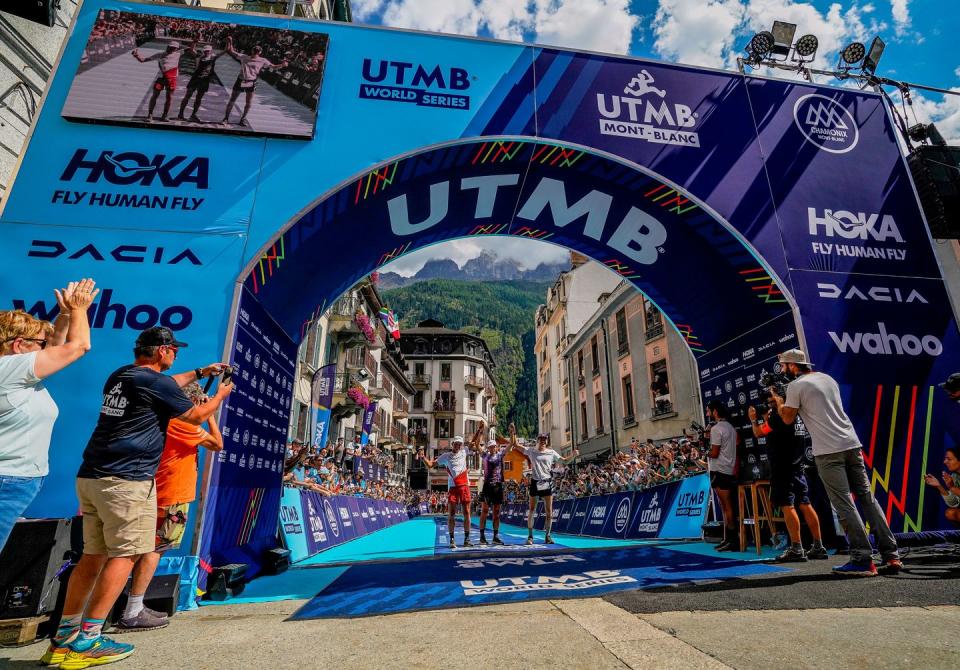
That victory lap in Chamonix is something every finisher gets to experience, and few forget. But if you’re among the first home, the reception is of a different magnitude. Rising British trail-running star Tom Evans was third in 2022, in a time (20:34:36) that would have won him the event most other years. He recalls the last kilometre being ‘wild’.‘Chamonix in UTMB week is the one time of the year when trail runners get to experience what it’s like to be a minor celebrity. But to finish on the podium... that’s more like, briefly, being an A-list celebrity,’ he says. ‘Everyone turns out to cheer you. It’s rammed, the noise is incredible. I don’t know any other race in any other sport that has that.’
For trail-running fans, those big UTMB moments over the past 20 years can seem as vivid as those of the Olympic Games. It’s a comparison that’s been made before – though I find the Mont Blanc showpiece more analogous to the Tour de France. It has the gauntlets of fans, the swooping aerials that soft-sell the region to the viewing millions and the see-saw drama
of the breakaways and pursuing pack. Others – more so in the United States, the most populous trail-running market – compare the race to the Super Bowl.
‘These comparisons are wonderful,’ enthuses Catherine Poletti. ‘It shows the race means something to people. But the biggest difference between us and the Super Bowl, or the Tour de France, or even the Olympics is that with those events you only have the elite competing. We also have regular runners. If I was a little bit arrogant, I’d say the UTMB is better!’
The Super Bowl comparison seems strikingly inapt –instead of hubris and showmanship, you’ll find only humility and sportsmanship in the Alps. Yet there are two pertinent similarities. The first is the rebranding of Chamonix’smarquee gathering as the ‘UTMB World Series Finals’ – the season finale into which all other events flow. The second is that rising commercialisation.
It was May 2021 when UTMB announced the Ironman alliance and declared that non-elite runners would have to complete at least one of the new global events if they wanted to enter the lottery for a place in Chamonix’s coveted showpiece. The backlash was immediate and, in some quarters, ferocious.
Yet far from a knee-jerk, avaricious land grab, the partnership and restructure were the denouement of a protracted, at times anguished, process. As far back as 2016, the Polettis began licensing the UTMB brand to countries such as Oman and Thailand as they flirted with a more global reach. UTMB International, launched in 2018, came next, partly motivated by the rapid rise of trail running in Asia.
Prior to the advent of the World Series, numerous potential buyers, including ASO –organisers of the Tour de France – and Spartan had been circling. Ironman, too, had the financial muscle and strategic nous to build its own global ultra series. In trail-running terms, the Polettis were out ahead, with the competition bearing down. Did they risk being overrun, or – in true UTMB tradition – form a strategic partnership to help them conquer the next peak?
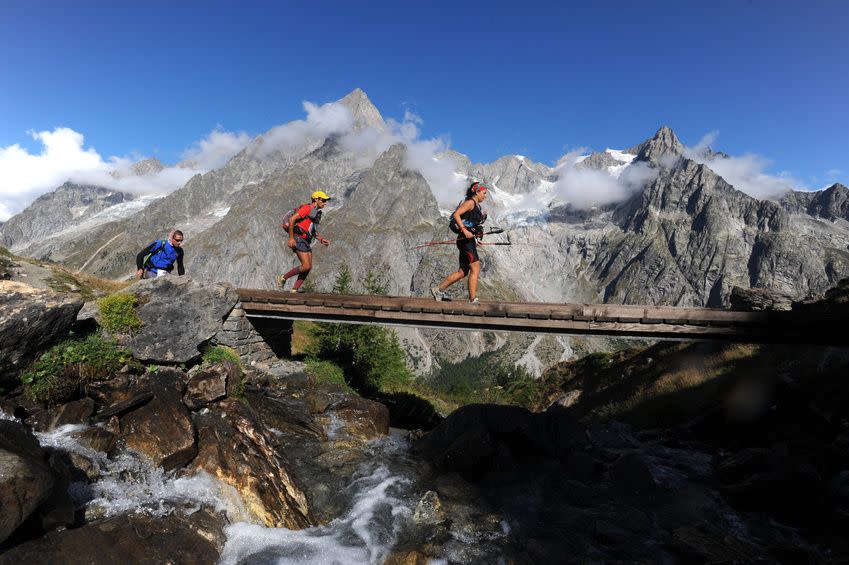
Under the terms of the agreement, Ironman gained a minority share, and the newly acquired global races took on the smaller French company’s values, standards and name (‘by UTMB’ is the chosen nomenclature, a suffix now affixed to all World Series events with the exception of the iconic Western States 100). Thirty-six events is the latest tally, up from 25 in the first year of the new structure.
How many World Series events would you ultimately like to operate, I ask Catherine Poletti. ‘If we have 50 to 60 that are well organised, respecting the values we had in the beginning, respecting the runners, the nature, the locals... I would love that!’ she answers. Given there are thousands of trail-running and ultra events globally, and an exponentially expanding market – participation is up by 345% in the past 10 years, according to a report by RunRepeat and IAU in 2020 – that hardly represents global saturation.
What’s harder to refute is that entry to the flagship event in Chamonix – never exactly a breeze – has become markedly more complicated. It’s a logistical marathon involving the recent completion of one of 4,000 UTMB Index races (demonstrating your capacity to run a given distance), and the accumulation of Running Stones to enter the lotteries for the three key Mont Blanc events: the 100-mile-plus UTMB, the 100K CCC and the 50K OCC (Orsières-Champex-Chamonix). The more stones, the better your chances.
‘We wanted a new system where every runner who really wanted to come to Chamonix could, and not spend 10 to 15 years trying the lottery and failing each year,’ says Michel Poletti. Fine, but surely the new system favours those with the means to globe-trot their way through the World Series calendar? And what of the associated environmental cost? Michel ponders my questions. ‘We’re really aware of all the concern around climate change, it’s part of our DNA,’ he says. ‘We are trying to give the possibility for anyone to qualify [for Mont Blanc] close to them. We are not against travelling; we just ask people to travel less and better.’
‘We will have to evolve and adapt in the future,’ he adds. ‘We have not made any decisions, but maybe we could arrive at the step of no more Running Stones if you travel. We certainly don’t want a runner to travel to Thailand then immediately America and then Australia just to collect them.’
An American man may never have won the UTMB, but one has written the definitive book on the event. Doug Mayer, a Chamonix-based author, journalist and founder of trail-running tour company Run the Alps, is a two-time finisher and the closest the race has to an oracle. In The Race That Changed Running: The Inside Story Of UTMB, his deep affection for thePolettis’ creation is palpable. The annual Mont Blanc loop is the frontrunner, by a distance, in his own 50-ultra running career.
‘You just know that UTMB is going to be a moment in your life that you’re going to remember forever,’ he says. I want to know from Mayer who, if anyone, he feels exemplifies this extraordinary race. A single person. He points to the now-nonagenarian René Bachelard, the low-profile galvaniser-in-chief, still a runner and still a feature around Chamonix in race week – for those who know who they’re looking for.
‘But, really, it’s the everyman,’ says Mayer. ‘Those men and women battling themselves and the mountains, those who run through two nights to reach the finish. The elite athletes are cool – really remarkable humans. But the core of the UTMB is the quiet sufferers.’
Dauwalter agrees. ‘It doesn’t matter where you finish; no one is going to ask you your time or pace or splits,’ she says. ‘This is about people trying something that sounds too difficult and surprising themselves. You have this huge experience and that bonds you. That’s the soul of UTMB – and of ultrarunning.’
You Might Also Like

 Yahoo News
Yahoo News 
